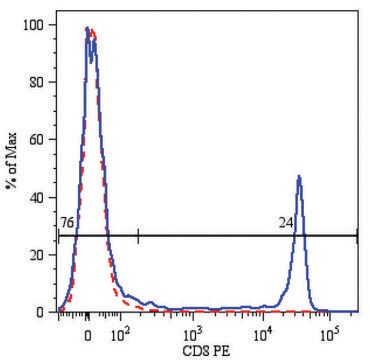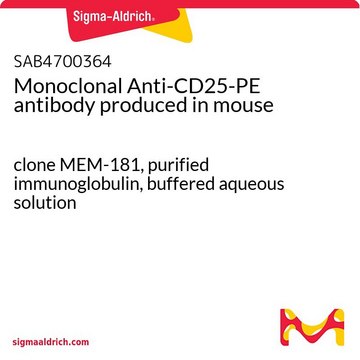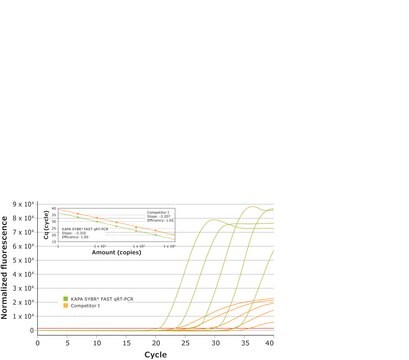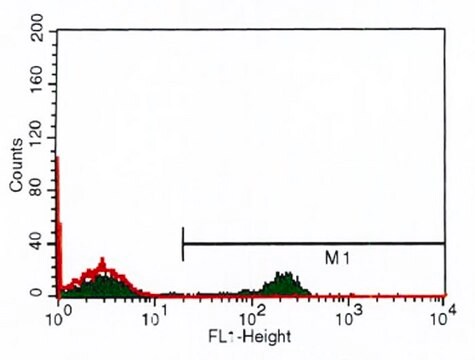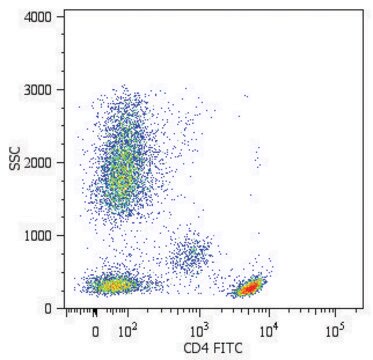推薦產品
一般說明
Anti-CD4-FITC antibody, mouse monoclonal (mouse IgG1 isotype) is derived from the hybridoma produced by the fusion of mouse myeloma cell line NS-1 and splenocytes from Balb/c mice immunized with cluster of differentiation 4 (CD4)-transfected mouse T cell hybridoma, 3DT, followed by CD4+ human T cell CEM cells (leukemic lymphoblasts).
CD4, a glycoprotein, is predominantly expressed on the cell membrane of mature, thymus-derived (T) lymphocyte and also to some extent in the monocyte/macrophage lineage. It has a transmembrane domain, cytoplasmic region and an extracellular region of four tandem domain similar like members of Ig superfamily.
特異性
Recognizes the CD4. The epitope recognized by the Q4120 clone is located on 1-183 aa and is sensitive to formalin fixation and paraffin embedding. 5th Workshop: code no. CD04.11
免疫原
CD4-transfected mouse T-cell hybridoma, 3DT, followed by CD4+ human T-cell CEM cells.
應用
FITC Conjugated Monoclonal Anti-Human CD4 has been used for:
- identification, quantification and monitoring of helper/inducer T cells in peripheral blood, biological fluids, lymphoid organs, and other tissues
- analysis of T cell mediated cytotoxicity
- characterization of subtypes of T cell leukemias and lymphomas
- studies of T cells in health and disease
- flow cytometry
生化/生理作用
CD4+ T cells acts as a helper/inducer, in providing an activating signal to B cells. It induces T lymphocytes bearing the reciprocal CD8 marker to become cytotoxic/suppressor cells. It is also majorly associated with non-polymorphic region of MHC (major histocompatibility complex) antigen in interacting with targets bearing MHC class II molecules. Thus, it is called as an adhesion molecule. It also behaves as receptor for the GP 120 envelope glycoprotein of human immunodeficiency virus. The CD4 molecules is involved in the adhesion of T lymphocytes to target cells, thymic development, transmission of intracellular signals during T cell activation, and binding to polyclonal immunoglobulins.
Immunoregulatory T cell subset abnormalities in autoimmunity disorders, immunodeficiency diseases, graft versus host disease and following immunosuppressive therapy are often manifested as a change in CD4+/CD8+ ratio in peripheral blood T cells.
標靶描述
CD4 is a single chain transmembraneous glycoprotein from the immunoglobulin superfamily. It is expressed on the helper/inducer T subset, on most medullary thymocytes, on microglial, dendritic and on some malignancies of T cell origin. The antigen binds to MHC class II molecules and is associated with p56lck protein tyrosine kinase.
外觀
Solution in 0.01 M phosphate buffered saline, pH 7.4, containing 1% bovine serum albumin and 15 mM sodium azide.
準備報告
Prepared by conjugation to fluorescein isothiocyanate isomer I (FITC). This green dye is efficiently excited at 495 nm and emits at 525 nm.
免責聲明
Unless otherwise stated in our catalog or other company documentation accompanying the product(s), our products are intended for research use only and are not to be used for any other purpose, which includes but is not limited to, unauthorized commercial uses, in vitro diagnostic uses, ex vivo or in vivo therapeutic uses or any type of consumption or application to humans or animals.
未找到適合的產品?
試用我們的產品選擇工具.
儲存類別代碼
10 - Combustible liquids
水污染物質分類(WGK)
nwg
閃點(°F)
Not applicable
閃點(°C)
Not applicable
個人防護裝備
Eyeshields, Gloves, multi-purpose combination respirator cartridge (US)
分析證明 (COA)
輸入產品批次/批號來搜索 分析證明 (COA)。在產品’s標籤上找到批次和批號,寫有 ‘Lot’或‘Batch’.。
The production of armed effector T cells
Janeway, et al.
Immunobiology (2001)
Qi-Zhi Zhang et al.
Molecular medicine reports, 22(5), 3629-3634 (2020-10-02)
Phosphoinositide 3-kinase catalytic subunit δ isoform (P110δ) is mainly expressed in white blood cells. It is involved in T and B lymphocyte differentiation, maturation and the neutrophil chemotaxis process. Apolipoprotein E (ApoE) is an arginine‑rich alkaline protein, which is present
Variation of blood T lymphocyte subgroups in patients with non-small cell lung cancer
Wang WJ, et al.
Asian Pacific Journal of Cancer Prevention, 14(8), 4671-4673 (2013)
Ravi Tandon et al.
AIDS research and human retroviruses, 30(7), 654-664 (2014-05-03)
Galectin-9 (Gal-9) is a β-galactosidase-binding lectin that promotes apoptosis, tissue inflammation, and T cell immune exhaustion, and alters HIV infection in part through engagement with the T cell immunoglobulin mucin domain-3 (Tim-3) receptor and protein disulfide isomerases (PDI). Gal-9 was
The CD4 antigen: physiological ligand and HIV receptor.
Q J Sattentau et al.
Cell, 52(5), 631-633 (1988-03-11)
我們的科學家團隊在所有研究領域都有豐富的經驗,包括生命科學、材料科學、化學合成、色譜、分析等.
聯絡技術服務